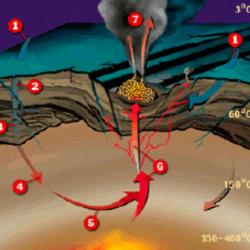Source Institutions
Source Institutions
Add to list Go to activity
Activity link broken? See if it's at the internet archive

In this activity, groups of learners work together to create edible models of chemicals involved in autotrophic nutrition. Learners use candy to represent elements involved in the chemical equations for chemosynthesis and photosynthesis. Learners complete a Lab Report based on their findings and understanding of chemosynthesis and photosynthesis. This detailed lesson guide includes background information, additional information for teachers of deaf students, and extensions.
- Under 5 minutes
- 1 to 2 hours
- $5 - $10 per group of students
- Ages 14 - 18
- Activity, Lesson/Lesson Plan, Model
- English
Quick Guide
Materials List (per group of students)
- Tablecloths
- Napkins
- Decorator's icing (or glue)
- Soft candies
- Toothpicks
- Small paper plates
- Poster paper
- Non-toxic colored markers
Subjects
-
Earth and Space Science
-
Earth Processes
- Volcanoes and Plate Tectonics
- Geochemical Cycles
-
Earth Structure
- Oceans and Water
-
Earth Processes
-
Life Sciences
- Cells
-
Diversity of Life
- Plants
- Animals
- Viruses and Bacteria
-
Ecology
- Ecosystems
- Populations
- Energy Flow and Chemical Cycles
-
Physical Sciences
- Energy
-
Chemistry
- Chemical Reactions
-
Structure and Properties of Matter
- Elements and Periodic Table
-
Mathematics
-
Algebra
- Equations and Inequalities
- Variables and Expressions
- Representation
-
Algebra
Informal Categories
- Animals
- Food and Cooking
- Model Building
- Nature and Environment
Audience
To use this activity, learners need to:
- see
- read
- touch
Learning styles supported:
- Involves teamwork and communication skills
- Involves hands-on or lab activities
Other
Includes alignment to state and/or national standards:
This resource is part of:
Access Rights:
- Free access
By:
- Williams, Kimberly
Rights:
- All rights reserved, National Oceanic and Atmospheric Administration,
